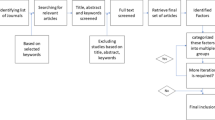Abstract
This study is intended to identify factors, which influence suppliers’ participation in the private electronic market (PEM). The results of this study show that many suppliers do not recognize the potential benefits that PEM could offer and they do not believe their off-line relationships with a buyer could be transferred to on-line. Thus, buyers need to convince their suppliers that PEM is not just a price based marketplace but instead a business model where mutual benefits can be achieved based on existing trust relationships between a buyer and limited number of qualified suppliers.


Similar content being viewed by others
References
Anderson E, Weitz B (1989) Determinant of continuity in conventional industrial channel dyads. Mark Sci 8(4):310–323
Bakos J, Brynjolfsson E (1993) From vendors to partners: information technology and incomplete contract in buyer–supplier relationships. J Organ Comput 3(3):301–328
Banker R, Kalvenes J, Patterson R (2000) Information technology, contract completeness, and buyer–supplier relationships. ICIS2000 proceedings, pp 218–228
Barua A, Lee B (1997) An economic analysis of the introduction of an electronic data interchange system. Inf Syst Res 8(4):398–422
Blau P (1964) Exchange and power in social life. Wiley, New York, pp 88–97
Burrow P (1990) EDI: still awaiting takeoff but already flying high. Electron Bus 16(13):60–61
Business Week (2005a) The best global brand: the 100 top brands, August 7
Business Week (2005b) The information technology 100, June 20
Cap Gemini Ernst & Young (2001) Unraveling the private marketplace mystique, accessed 15 July 2003 at http://www.us.cgey.com
Chau P, Hui K (2001) Determinants of small business EDI adoption: an empirical investigation. J Organ Comput Electron Commer 11(4):229–252
Chwelos P, Benbasat I, Dexter A (2001) Research report: empirical test of an EDI adoption model. Inf Syst Res 12(3):304–321
Clemons E, Peddi S, Row M (1993) The impact of information technology on the organization of economic activity: the “move to the middle” hypothesis. J Manag Inf Syst Fall:10–35
Dao Q, Kauffman R (2000) To be or not to B2B?: an evaluative model for E-Procurement channel adoption. Fifth INFORMS conference on information systems and technology, November, San Antonio
Dyer J (1996) Specialized supplier networks as a source of competitive advantage: evidence from the auto industry. Strateg Manag J 17(4):271–291
Dyer J, Chu W (2000) The determinants of trust in supplier–automaker relationships in the US, Japan, and Korea. J Int Bus Stud 31(2):259–285
Ganesan S (1994) Determinants of long-term orientation in buyer–seller relationships. J Mark 58:1–19
Gravetter F, Wallnau L (1996) Statistics for the behavioral sciences. West Publishing Company, St Paul
Grewal R, Comer J, Metha R (2001) An investigation into the antecedents of organizational participation in business-to-business electronic markets. J Mark 65:17–23
Grossman S, Hart O (1986) The cost and benefits of ownership: a theory of vertical and lateral integration. J Polit Econ 24(4):691–717
Hart O, Moore J (1990) Property right and the nature of the firm. J Polit Econ 98(6):1119–1158
Hart O, Moore J (1999) Foundation of incomplete contract. Rev Econ Stud 66:115–138
Hart P, Saunders C (1997) Power and trust: critical factors in the adoption and use of electronic data interchange. Organ Sci 8(1):23–42
Hess C, Kemerer C (1994) Computerized loan origination system: an industry case study of the electronic market hypothesis. MIS Q 18(3):251–275
Howells J, Wood M (1995) Diffusion and management of electronic data interchange: Barriers and opportunities and healthcare industries. Technol Anal Strateg Manag 7(4):371–386
Iacovou C, Banbasat I, Dexter A (1995) Electronic data interchange and impact of technology. MIS Q 19(4):465–485
IBM Global Services (2001) Private exchanges: looking to the pioneers for value earned and lessons learned
Jupiter Research Center (2001) Vision report, 1, April 10
Kirchsteiger G, Niederle M, Potters J (2001) Public versus private exchanges. Discussion paper, Tilburg University, Center for Economic Research
Kumar N (1996) The power of trust in manufacturer–retailer relationships. Harv Bus Rev 74(6):92–109
Laudon K, Laudon J (2005) Management information systems: managing the digital firm. Prentice-Hall, Upper Saddle River
Laudon K, Traver C (2006) E-commerce: business, technology, society. Addison-Wesley, Boston
Lee SM (2003) From the land of morning calm to ICT hot bed, Acad Manag Exec 17(2):7–18
Lee S, Lim G (2005) The impact of partnership attributes on EDI implementation success. Inf Manag 42:505–516
Maingot M, Quon T (2000) A survey of electronic data interchange (EDI) in Canada, including a discussion of EDI audit issues and audit implications. Proceedings of 23rd annual congress of EAA, Munich
Mohan S (1995) EDI’s move to prime time stalled by cost perception. Computerworld 29(8):91
Moozakis C (2001) Update: new CEO should shape up covisint. http://www.InternetWeek.com, April
Mukhopadhyay T, Kekre S, Kalathur S (1995) Business value of information technology: a study of electronic data interchange. MIS Q 19(2):137–156
Munson C, Rosenblatt M, Rosenblatt Z (1999) The use and abuse of power in supply chains. Bus Horiz 42(Jan–Feb):55–65
Nunally J (1978) Psychometric, 2nd edn. McGraw Hill, New York
O’Callaghan R, Kaufmann P, Konsynski (1992) Adoption correlates and share effects of electronic data interchange systems in marketing channels. J Mark 56:45–56
Parkhe A (1998) Understanding trust in international alliances. J World Bus 33(3):219–240
Pedhazur E (1997) Multiple regression in behavioral research, 3rd edn. Harcourt Brace, Forth Worth
Pierce R (2002) XML spells the end for EDI eventually. http://www.AccountancyAge.com, July 23
Premkumar G, Ramamurthy K (1995) The role of interorganizational and organizational factors on the decision mode for adoption of interorganizational systems. Decis Sci 26(3):303–336
Premkumar G, Ramamurthy K, Nilakanta S (1994) Implementation of electronic data interchange: an innovation diffusion perspective. J Manag Inf Syst 11(2):157–186
Ramamurthy K, Premkumar G, Crum M (1999) Organizational and interorganizatioal determinants of EDI diffusion and organizational performance: a causal model. J Organ Comput 9(4):253–285
Ratnasingam P (2000) The influence of power on trading partner trust in electronic commerce. Internet Res Electron Netw Appl Policy 10(1):56–62
Smeltzer L (1997) The meaning and origin of trust in buyer–supplier relationships. Int J Purch Mater Manag 33(Jan):40–48
Subramani M, Walden E (2000) Economic returns to firms from business-to-business electronic commerce initiatives: an empirical examination. The ICIS2000 proceedings 229–241
Teo H, Wei K, Benbasat I (2003) Predicting intention to adopt interorganizational linkages: an institutional perspective. MIS Q 27(1):19–49
Vijayasarathy L, Tyler M (1997) Adoption factors and electronic data interchange use: a survey of retail companies. Int J Retail Distrib Manag 25(9):286–292
Wang E, Seidmann A (1995) Electronic data interchange: competitive externalities and strategic implementation policies. Manag Sci 41(3):401–418
Whitaker J, Stephens J, Traham C (2001) Successfully securing suppliers. Supply Chain Excellence 4, May 29
Williams L (1994) Understanding distribution channels: an inter-organizational study of EDI adoption. J Bus Logist 15(2):173–203
Williamson O (1975) Market and hierarchies. Free, New York
Wise R (2000) Beyon the exchange: the future of B2B. Harv Bus Rev Nov–Dec:88–96
Young-Ybarra C, Wiersema M (1999) Strategic flexibility in information technology alliance: the influence of transaction cost economics and social exchange theory. Organ Sci 10(4):439–459
Zaheer A, McEvily B, Perrone V (1998) Does trust matter?: exploring the effects of interorganizational and interpersonal trust on performance. Organ Sci 9(2):141–159
Author information
Authors and Affiliations
Corresponding author
Rights and permissions
About this article
Cite this article
Lee, S.M., Lim, Sb. Factors influencing suppliers’ participation in private electronic markets. Service Business 1, 41–62 (2007). https://doi.org/10.1007/s11628-006-0005-8
Received:
Accepted:
Published:
Issue Date:
DOI: https://doi.org/10.1007/s11628-006-0005-8




